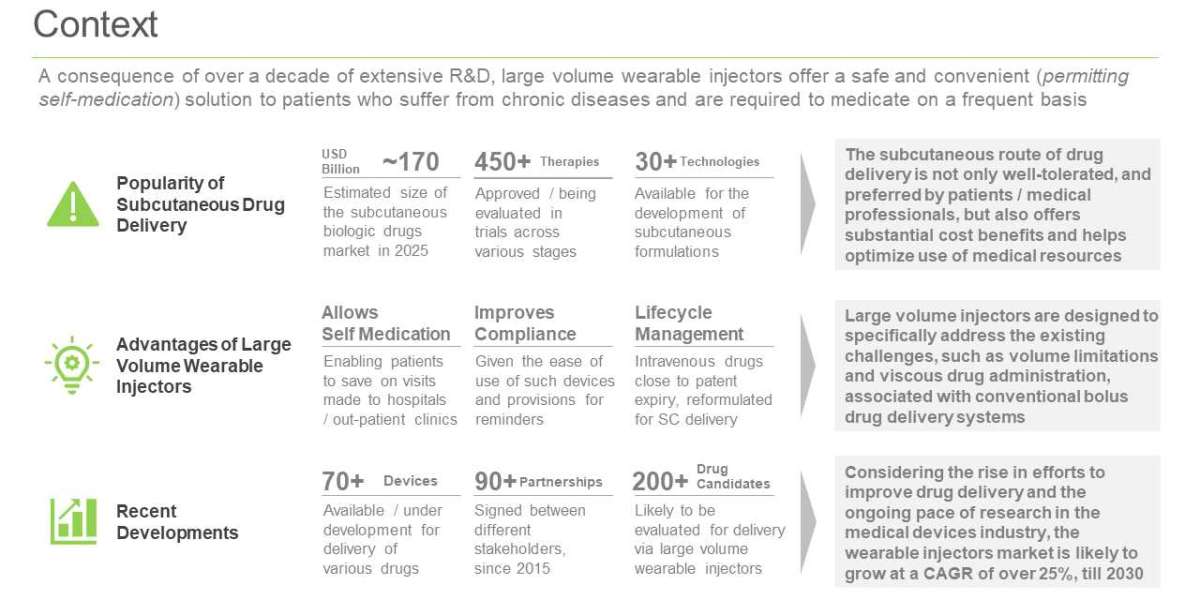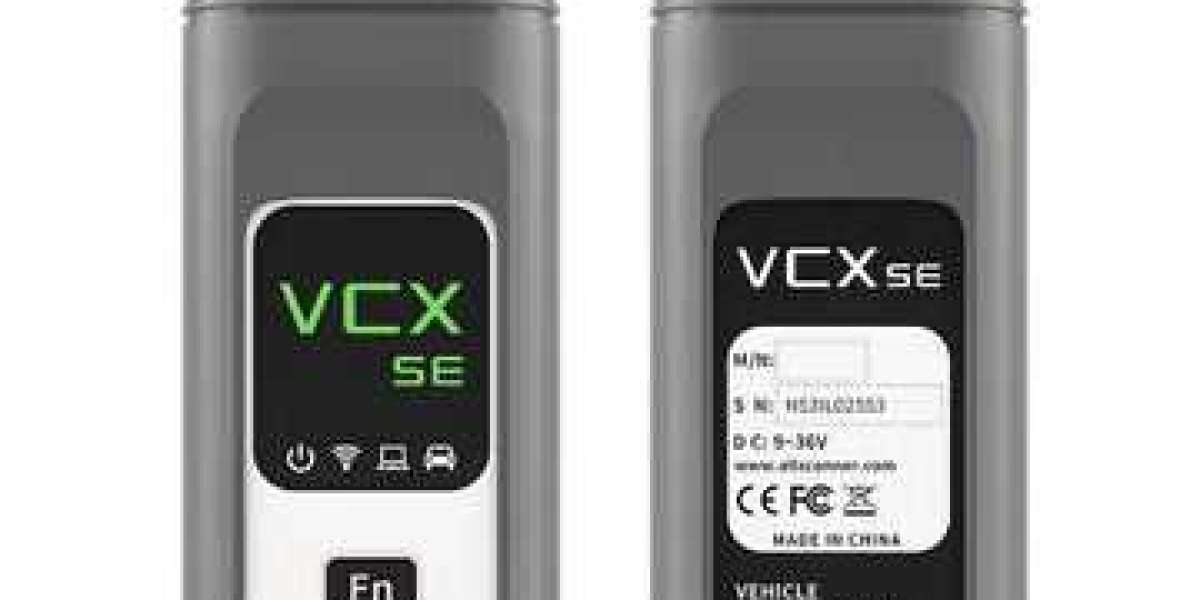Roots Analysis has done a detailed study on Large Volume Wearable Injectors Market (5th Edition), 2020-2030: Focus on Bolus, Basal and Continuous Delivery Devices.”, covering key aspects of the industry’s current trends and identifying potential future growth opportunities.
To order this 540+ page report, which features 175+ figures and 200+ tables, please visit this - https://www.rootsanalysis.com/reports/view_document/large-volume-wearable-injectors/238.html
Key Market Insights
- More than 40 large volume wearable injectors are presently available / under development for the administration of drugs, beyond insulin, including 15+ drug device combinations
- Companies focused on developing devices for the delivery of insulin have already established strong brand positions in this domain, with 30+ devices currently under development or available
- More than 200 biologics / small molecule drugs were identified as likely products to be developed in combination with large volume wearable injectors
- The rising interest in this field is reflected in the number of partnerships (90+) inked between 2015
and 2020 (till June), involving both international and indigenous stakeholders, across the world
- An evaluation of 50+ stakeholders engaged in the development of large volume wearable injectors revealed the existence of several likely acquisition targets, across different geographical regions
- The market, for the large volume wearable injectors for the delivery of non-insulin drugs is projected to be worth USD 600 million; owing to the increasing incidence of chronic clinical conditions and growing pipeline of therapeutic interventions to treat such diseases
- The large volume wearable injectors market for insulin is anticipated to be worth over USD 2.7 billion by 2030; the anticipated opportunity is likely to be distributed across various different device types, therapeutic areas and geographies
For more information, please visit https://www.rootsanalysis.com/reports/view_document/large-volume-wearable-injectors-market-4th-edition-2018-2030/238.html
Table of Contents
- PREFACE
1.1. Scope of the Report
1.2. Research Methodology
1.3. Chapter Outlines
- EXECUTIVE SUMMARY
- INTRODUCTION
3.1. Chapter Overview
3.2. An Overview of Drug Delivery Devices
3.3. Conventional Parenteral Drug Delivery
3.3.1 Needlestick Injuries
3.4. Emergence of Self-Administration Devices
3.4.1. Driving Factors
3.5. Available Self-Injection Devices
3.5.1. Prefilled Syringes
3.5.2. Pen-Injectors
3.5.3. Needle-Free Injectors
3.5.4. Autoinjectors
3.5.5. Large Volume Wearable Injectors
3.6. Regulatory Considerations
3.6.1. Medical Devices
3.6.2. Drug Device Combination Products
3.7. Future Perspectives of Self-Injection Systems
- LARGE VOLUME WEARABLE INJECTORS: CURRENT MARKET LANDSCAPE
4.1. Chapter Overview
4.2. Large Volume Wearable Injectors: Overall Market Landscape
4.2.1. Large Volume Wearable Injectors for Non-Insulin Drugs: Market Landscape
4.2.1.1. Analysis by Stage of Development
4.2.1.2. Analysis by Type of Device
4.2.1.3. Analysis by Type of Dose
4.2.1.4. Analysis by Route of Administration
4.2.1.5. Analysis by Mode of Injection
4.2.1.6. Analysis by Volume / Storage Capacity
4.2.1.7. Analysis by Actuation Mechanism
4.2.1.8. Analysis by Usability
4.2.1.9. Analysis by Availability of Prefilled Drug Reservoir
4.2.1.10. Analysis by Availability of Connectivity
4.2.2. Large Volume Drug Device Combinations: Market Landscape
4.2.2.1. Analysis by Stage of Development
4.2.2.2. Analysis by Type of Device
4.2.2.3. Analysis by Drug Compatibility
4.2.2.4. Analysis by Type of Dose
4.2.2.5. Analysis by Route of Administration
4.2.2.6. Analysis by Mode of Injection
4.2.2.7. Analysis by Therapeutic Area
4.2.2.8. Analysis by Volume / Storage Capacity
4.2.2.9. Analysis by Usability
4.2.3. Large Volume Wearable Injectors for Non-Insulin Drugs: Analysis of Developers (Devices and Drug Device Combinations)
4.2.3.1. Analysis by Year of Establishment
4.2.3.2. Analysis by Company Size
4.2.3.3. Analysis by Geography
4.2.4. Large Volume Wearable Injectors for Insulin: Market Landscape
4.2.4.1. Analysis by Stage of Development
4.2.4.2. Analysis by Type of Device
4.2.4.3. Analysis by Volume / Storage Capacity
4.2.4.4. Analysis by Usability
4.2.4.5. Analysis by Availability of Prefilled Insulin Cartridges
4.2.4.6. Analysis by Availability of CGM / BGM System
4.2.4.7. Analysis by Availability of Automated Insulin Delivery (AID) Feature
4.2.4.8. Analysis by Availability of Connectivity
4.2.4.9. Analysis by Type of Remote Control Features
4.2.5. Large Volume Wearable Injectors for Insulin: Analysis of Developers
4.2.5.1. Analysis by Year of Establishment
4.2.5.2. Analysis by Company Size
4.2.5.3. Analysis by Geography
- PRODUCT COMPETITIVENESS ANALYSIS
5.1. Chapter Overview
5.2. Methodology
5.3. Assumptions / Key Parameters
5.4. Product Competitiveness Analysis
5.4.1. Large Volume Wearable Injectors for Non-Insulin Drugs
5.4.2. Large Volume Drug Device Combinations
5.4.3. Large Volume Wearable Injectors for Insulin
- LARGE VOLUME WEARABLE INJECTORS: KEY PLAYERS
6.1. Chapter Overview
6.2. Large Volume Wearable Injectors for Non-Insulin Drugs: Key Players
6.2.1. Becton Dickinson
6.2.1.1. Company Snapshot
6.2.1.2. Financial Information
6.2.1.3. Product Portfolio
6.2.1.4. Recent Developments and Future Outlook
6.2.2. Bespak
6.2.2.1. Company Snapshot
6.2.2.2. Financial Information
6.2.2.3. Product Portfolio
6.2.2.4. Recent Developments and Future Outlook
6.2.3. Enable Injections
6.2.3.1. Company Snapshot
6.2.3.2. Product Portfolio
6.2.3.3. Recent Developments and Future Outlook
6.2.4. Insulet
6.2.4.1. Company Snapshot
6.2.4.2. Financial Information
6.2.4.3. Product Portfolio
6.2.4.4. Recent Developments and Future Outlook
6.2.5. Roche
6.2.5.1. Company Snapshot
6.2.5.2. Financial Information
6.2.5.3. Product Portfolio
6.2.5.4. Recent Developments and Future Outlook
6.2.6. Sensile Medical
6.2.6.1. Company Snapshot
6.2.6.2. Product Portfolio
6.2.6.3. Recent Developments and Future Outlook
6.2.7. Sonceboz
6.2.7.1. Company Snapshot
6.2.7.2. Product Portfolio
6.2.7.3. Recent Developments and Future Outlook
6.2.8. SteadyMed Therapeutics
6.2.8.1. Company Snapshot
6.2.8.2. Product Portfolio
6.2.8.3. Recent Developments and Future Outlook
6.2.9. Weibel CDS
6.2.9.1. Company Snapshot
6.2.9.2. Product Portfolio
6.2.9.3. Recent Developments and Future Outlook
6.2.10. West Pharmaceutical Services
6.2.10.1. Company Snapshot
6.2.10.2. Financial Information
6.2.10.3. Product Portfolio
6.2.10.4. Recent Developments and Future Outlook
6.3. Large Volume Wearable Injectors for Insulin: Key Players
6.3.1. CeQur
6.3.1.1. Company Snapshot
6.3.1.2. Product Portfolio
6.3.1.3. Recent Developments and Future Outlook
6.3.2. Debiotech
6.3.2.1. Company Snapshot
6.3.2.2. Product Portfolio
6.3.2.3. Recent Developments and Future Outlook
6.3.3. Eli Lilly
6.3.3.1. Company Snapshot
6.3.3.2. Financial Information
6.3.3.3. Product Portfolio
6.3.3.4. Recent Developments and Future Outlook
6.3.4. Medtronic
6.3.4.1. Company Snapshot
6.3.4.2. Financial Information
6.3.4.3. Product Portfolio
6.3.4.4. Recent Developments and Future Outlook
6.3.5. PharmaSens
6.3.5.1. Company Snapshot
6.3.5.2. Product Portfolio
6.3.5.3. Recent Developments and Future Outlook
6.3.6. SOOIL Development
6.3.6.1. Company Snapshot
6.3.6.2. Product Portfolio
6.3.6.3. Recent Developments and Future Outlook
6.3.7. Tandem Diabetes Care
6.3.7.1. Company Snapshot
6.3.7.2. Financial Information
6.3.7.3. Product Portfolio
6.3.7.4. Recent Developments and Future Outlook
- DRUG-DEVICE COMBINATIONS: TABULATED PROFILES
7.1. Chapter Overview
7.2. Apomorphine / D-mine® Pump
7.3. Apomorphine / ND0701
7.4. Bupivacaine / SMT-301
7.5. Ceftriaxone / sc2Wear® Infusor
7.6. Furosemide / 3 mL Micropump
7.7. Furosemide / FUROSCIX® On-body Infusor
7.8. Herceptin® / Single Use Injector
7.9. Ketorolac / SMT-201
7.10. Levodopa and Carbidopa / ND0612 and ND0901
7.11. Lutrepulse / The LUTREPULSE® System
7.12. Neulasta® / Neulasta OnPro™ On-body Injector
7.13. Repatha® / Pushtronex® System
7.14. Treprostinil / Trevyent®
- PARTNERSHIPS AND COLLABORATIONS
8.1. Chapter Overview
8.2. Partnership Models
8.3. Large Volume Wearable Injectors: List of Partnerships and Collaborations
8.3.1. Analysis by Year of Partnership
8.3.2. Analysis by Type of Partnership
8.3.3. Analysis by Type of Device
8.3.4. Analysis by Year of Partnership and Type of Partner
8.3.5. Most Active Players: Analysis by Number of Partnerships
8.3.6. Regional Analysis
8.3.7. Intercontinental and Intracontinental Agreements
- KEY ACQUISITION TARGETS
9.1. Chapter Overview
9.2. Scope and Methodology
9.3. Scoring Criteria and Key Assumptions
9.4. Potential Strategic Acquisition Targets for Non-Insulin Drug Delivery Players
9.5. Potential Strategic Acquisition Targets for Insulin Drug Delivery Players
9.6. Concluding Remarks
- PATENT ANALYSIS
10.1. Chapter Overview
10.2. Scope and Methodology
10.3. Large Volume Wearable Injectors: Patent Analysis
10.3.1. Analysis by Publication Year
10.3.2. Analysis by Issuing Authority / Patent Offices Involved
10.3.3. Analysis by CPC Symbols
10.3.4. Emerging Focus Areas
10.3.5. Analysis by Type of Organization
10.3.6. Leading Players: Analysis by Number of Patents
10.4. Large Volume Wearable Injectors: Patent Benchmarking Analysis
10.4.1. Analysis by Patent Characteristics
10.5. Large Volume Wearable Injectors: Patent Valuation Analysis
- LARGE VOLUME WEARABLE INJECTORS: LIKELY DRUG CANDIDATES
11.1. Chapter Overview
11.2. Marketed Drugs
11.2.1. Most Likely Candidates for Delivery via Large Volume Wearable Injectors
11.2.2. Likely Candidates for Delivery via Large Volume Wearable Injectors
11.2.3. Less Likely Candidates for Delivery via Large Volume Wearable Injectors
11.2.4. Unlikely Candidates for Delivery via Large Volume Wearable Injectors
11.3. Clinical Drug Candidates
11.3.1. Biologics
11.3.1.1. Most Likely Candidates for Delivery via Large Volume Wearable Injectors
11.3.1.2. Likely Candidates for Delivery via Large Volume Wearable Injectors
11.3.1.3. Less Likely Candidates for Delivery via Large Volume Wearable Injectors
11.3.1.4. Unlikely Candidates for Delivery via Large Volume Wearable Injectors
11.3.2. Small Molecules
11.3.2.1. Most Likely Candidates for Delivery via Large Volume Wearable Injectors
11.3.2.2. Likely Candidates for Delivery via Large Volume Wearable Injectors
11.3.2.3. Less Likely Candidates for Delivery via Large Volume Wearable Injectors
11.3.2.4. Unlikely Candidates for Delivery via Large Volume Wearable Injectors
- EMERGING TRENDS ON SOCIAL MEDIA
12.1. Chapter Overview
12.2. Large Volume Wearable Injectors: Trends on Twitter
12.2.1. Historical Trend in Volume of Tweets
12.2.2. Trending Words / Phrases Related to Large Volume Wearable Injectors
12.2.3. Most Influential Authors
12.2.4. Popular Players on Twitter
12.2.4.1. Roche (ACCU-CHEK® Solo Micropump System)
12.2.4.2. Insulet (Omnipod®)
12.2.4.3. Medtronic (MiniMed® Wearable Injectors)
12.2.4.4. Comparison of Popular Players Based on Number of Tweets
12.3. Concluding Remarks
- CLINICAL TRIAL ANALYSIS
13.1. Chapter Overview
13.2. Scope and Methodology
13.3. Large Volume Wearable Injectors: Clinical Trial Analysis
13.3.1. Analysis by Trial Registration Year
13.3.2. Analysis by Trial Phase
13.3.3. Analysis by Trial Recruitment Status
13.3.4. Analysis by Trial Registration and Number of Patients Enrolled
13.3.5. Analysis by Study Design
13.3.6. Analysis by Type of Sponsor / Collaborator
13.3.7. Leading Players: Analysis by Number of Registered Trials
13.3.8. Word Cloud: Key Focus Areas
13.3.9. Analysis by Therapeutic Area
13.3.10. Popular Drug Device Combinations: Analysis by Number of Registered Trials
13.3.11. Geographical Analysis by Number of Registered Trials
13.3.12. Geographical Analysis by Patients Enrolled
13.3.13. Analysis by Clinical Endpoints
- CASE STUDY: ROLE OF CMOs IN DEVICE DEVELOPMENT SUPPLY CHAIN
14.1. Chapter Overview
14.2. Device Development Supply Chain
14.3. Significance of CMOs in the Drug Delivery Device Development Process
14.4. List of Contract Manufacturing Organizations
14.4.1. Contract Manufacturers: Geographical Distribution and Services Offered
- REGULATORY AND REIMBURSEMENT LANDSCAPE FOR MEDICAL DEVICES
15.1. Chapter Overview
15.2. General Regulatory and Reimbursement Guidelines for Medical Devices
15.3. Regulatory and Reimbursement Landscape in North America
15.3.1. The US Scenario
15.3.2. The Canadian Scenario
15.3.3. The Mexican Scenario
15.4. Regulatory and Reimbursement Landscape in Europe
15.4.1. Overall Scenario
15.4.1.1. Overall Regulatory Authority
15.4.1.2. Overall Review / Approval Process
15.4.2. The UK Scenario
15.4.3. The French Scenario
15.4.4. The German Scenario
15.4.5. The Italian Scenario
15.4.6. The Spanish Scenario
15.5. Regulatory and Reimbursement Landscape in Asia-Pacific and Rest of the World
15.5.1. The Australian Scenario
15.5.2. The Brazilian Scenario
15.5.3. The Chinese Scenario
15.5.4. The Indian Scenario
15.5.5. The Israeli Scenario
15.5.6. The Japanese Scenario
15.5.7. The New Zealand Scenario
15.5.8. The Singaporean Scenario
15.5.9. The South Korea Scenario
15.5.10. The South African Scenario
15.5.11. The Taiwanese Scenario
15.5.12. The Thailand Scenario
15.6. Comparison of Regional Regulatory Environment
15.7. Concluding Remarks
- MARKET SIZING AND OPPORTUNITY ANALYSIS
16.1. Chapter Overview
16.2. Forecast Methodology and Key Assumptions
16.3. Global Large Volume Wearable Injectors Market for Non-Insulin Drugs, 2020-2030 (By Value)
16.3.1. Global Large Volume Wearable Injectors Market for Non-Insulin Drugs: Distribution by Type of Device, 2020-2030 (By Value)
16.3.2 Global Large Volume Wearable Injectors Market for Non-Insulin Drugs: Distribution by Usability, 2020-2030 (By Value)
16.3.3 Global Large Volume Wearable Injectors Market for Non-Insulin Drugs: Distribution by Therapeutic Area, 2020-2030 (By Value)
16.4 Large Volume Wearable Injectors Market for Non-Insulin Drugs in North America, 2020-2030 (By Value)
16.4.1 Large Volume Wearable Injectors Market for Non-Insulin Drugs in North America: Distribution by Type of Device, 2020-2030 (By Value)
16.4.2 Large Volume Wearable Injectors Market for Non-Insulin Drugs in North America: Distribution by Usability, 2020-2030 (By Value)
16.4.3 Large Volume Wearable Injectors Market for Non-Insulin Drugs in North America: Distribution by Therapeutic Area, 2020-2030 (By Value)
16.5 Large Volume Wearable Injectors Market for Non-Insulin Drugs in Europe, 2020-2030 (By Value)
16.5.1 Large Volume Wearable Injectors Market for Non-Insulin Drugs in Europe: Distribution by Type of Device, 2020-2030 (By Value)
16.5.2 Large Volume Wearable Injectors Market for Non-Insulin Drugs in Europe: Distribution by Usability, 2020-2030 (By Value)
16.5.3 Large Volume Wearable Injectors Market for Non-Insulin Drugs in Europe: Distribution by Therapeutic Area, 2020-2030 (By Value)
16.6 Large Volume Wearable Injectors Market for Non-Insulin Drugs in Asia Pacific, 2020-2030 (By Value)
16.6.1 Large Volume Wearable Injectors Market for Non-Insulin Drugs in Asia Pacific: Distribution by Type of Device, 2020-2030 (By Value)
16.6.2 Large Volume Wearable Injectors Market for Non-Insulin Drugs in Asia Pacific: Distribution by Usability, 2020-2030 (By Value)
16.6.3 Large Volume Wearable Injectors Market for Non-Insulin Drugs in Asia Pacific: Distribution by Therapeutic Area, 2020-2030 (By Value)
16.7. Global Large Volume Wearable Injectors Market for Non-Insulin Drugs, 2020-2030 (By Volume)
16.7.1. Global Large Volume Wearable Injectors Market for Non-Insulin Drugs: Distribution by Type of Device, 2020-2030 (By Volume)
16.7.2 Global Large Volume Wearable Injectors Market for Non-Insulin Drugs: Distribution by Usability, 2020-2030 (By Volume)
16.7.3 Global Large Volume Wearable Injectors Market for Non-Insulin Drugs: Distribution by Therapeutic Area, 2020-2030 (By Volume)
16.8 Large Volume Wearable Injectors Market for Non-Insulin Drugs in North America, 2020-2030 (By Volume)
16.8.1 Large Volume Wearable Injectors Market for Non-Insulin Drugs in North America: Distribution by Type of Device, 2020-2030 (By Volume)
16.8.2 Large Volume Wearable Injectors Market for Non-Insulin Drugs in North America: Distribution by Usability, 2020-2030 (By Volume)
16.8.3 Large Volume Wearable Injectors Market for Non-Insulin Drugs in North America: Distribution by Therapeutic Area, 2020-2030 (By Volume)
16.9 Large Volume Wearable Injectors Market for Non-Insulin Drugs in Europe, 2020-2030 (By Volume)
16.9.1 Large Volume Wearable Injectors Market for Non-Insulin Drugs in Europe: Distribution by Type of Device, 2020-2030 (By Volume)
16.9.2 Large Volume Wearable Injectors Market for Non-Insulin Drugs in Europe: Distribution by Usability, 2020-2030 (By Volume)
16.9.3 Large Volume Wearable Injectors Market for Non-Insulin Drugs in Europe: Distribution by Therapeutic Area, 2020-2030 (By Volume)
16.10 Large Volume Wearable Injectors Market for Non-Insulin Drugs in Asia Pacific, 2020-2030 (By Value)
16.10.1 Large Volume Wearable Injectors Market for Non-Insulin Drugs in Asia Pacific: Distribution by Type of Device, 2020-2030 (By Value)
16.10.2 Large Volume Wearable Injectors Market for Non-Insulin Drugs in Asia Pacific: Distribution by Usability, 2020-2030 (By Value)
16.10.3 Large Volume Wearable Injectors Market for Non-Insulin Drugs in Asia Pacific: Distribution by Therapeutic Area, 2020-2030 (By Value)
16.11. Global Large Volume Wearable Injectors Market for Insulin, 2020-2030
16.11.1 Global Large Volume Wearable Injectors Market for Insulin: Distribution by Type of Device, 2020-2030
16.11.2 Global Large Volume Wearable Injectors Market for Insulin: Distribution by Usability, 2020-2030
16.12 Large Volume Wearable Injectors Market for Insulin in North America, 2020-2030
16.12.1 Large Volume Wearable Injectors Market for Insulin in North America: Distribution by Type of Device, 2020-2030
16.12.2 Large Volume Wearable Injectors Market for Insulin in North America: Distribution by Usability, 2020-2030
16.13 Large Volume Wearable Injectors Market for Insulin in Europe, 2020-2030
16.13.1 Large Volume Wearable Injectors Market for Insulin in Europe: Distribution by Type of Device, 2020-2030
16.13.2 Large Volume Wearable Injectors Market for Insulin in Europe: Distribution by Usability, 2020-2030
16.14 Large Volume Wearable Injectors Market for Insulin in Asia Pacific, 2020-2030
16.14.1 Large Volume Wearable Injectors Market for Insulin in Asia Pacific: Distribution by Type of Device, 2020-2030
16.14.2 Large Volume Wearable Injectors Market for Insulin in Asia Pacific: Distribution by Usability, 2020-2030
- SWOT ANALYSIS
17.1. Chapter Overview
17.2. SWOT Analysis
17.2.1. Strengths
17.2.2. Weaknesses
17.2.3. Opportunities
17.2.4. Threats
17.3. Large Volume Wearable Injectors: Future Growth Opportunities
17.3.1. Rising Focus on Self-Administration of Drugs
17.3.2. Possibility of Integration with Mobile Applications
17.3.3. Potential Life Cycle Management Tool
17.3.4. Potential Usability for Multiple Therapeutic Areas
- EXECUTIVE INSIGHTS
18.1. Chapter Overview
18.2. Subcuject
18.2.1. Company Snapshot
18.2.2. Interview Transcript: Jesper Roested, Chief Executive Officer (Q2 2020)
18.3. Sorrel Medical
18.3.1. Company Snapshot
18.3.2. Interview Transcript: Mindy Katz, Director of Product (Q2 2020)
18.4. Medipacs
18.4.1. Company Snapshot
18.4.2. Interview Transcript: Mark Banister, Chief Executive Officer (Q3 2016)
18.5. Elcam Medical
18.5.1. Company Snapshot
18.5.2. Interview Transcript: Menachem Zucker, Vice President and Chief Scientist (Q3 2016)
18.6. West Pharmaceutical Services
18.6.1. Company Snapshot
18.6.2. Interview Transcript: Graham Reynolds, Vice President and General Manager, Biologics (Q3 2016)
18.7. Enable Injections
18.7.1. Company Snapshot
18.7.2. Interview Transcript: Michael Hooven, Chief Executive Officer (Q3 2014)
18.8. scPharmaceuticals
18.8.1. Company Snapshot
18.8.2. Interview Transcript: Pieter Muntendam, former President and Chief Executive Officer (Q3 2014)
- APPENDIX 1: TABULATED DATA
- APPENDIX 2: LIST OF COMPANIES AND ORGANIZATIONS
About Roots Analysis
Roots Analysis is one of the fastest growing market research companies, sharing fresh and independent perspectives in the bio-pharmaceutical industry. The in-depth research, analysis and insights are driven by an experienced leadership team which has gained many years of significant experience in this sector. If you’d like help with your growing business needs, get in touch at info@rootsanalysis.com
Contact Information
Roots Analysis Private Limited
Ben Johnson
+1 (415) 800 3415
Facebook - https://www.facebook.com/RootsAnalysis
LinkedIn - https://www.linkedin.com/company/roots-analysis/mycompany/
Twitter - https://twitter.com/RootsAnalysis
Medium - https://medium.com/@RootsAnalysis
Pinterest - https://in.pinterest.com/RootsanalysisPin/_saved/








